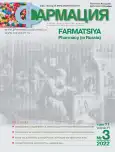Study of inflorescences of broccoli (Brassica oleracea L. var. Italica) at phenolic compounds and antioxidant activity
- Authors: Potapova D.A.1, Rendyuk T.D.1
-
Affiliations:
- Sechenov First Moscow State Medical University (Sechenov University)
- Issue: Vol 71, No 3 (2022)
- Pages: 24-28
- Section: Articles
- URL: https://journals.eco-vector.com/0367-3014/article/view/113704
- DOI: https://doi.org/10.29296/25419218-2022-03-04
- ID: 113704
Cite item
Abstract
Introduction. Brassicaceae vegetables are considering as functional foods owing to their unique chemical composition health-promoting properties. In particular, broccoli (Brassica oleracea L. var. italica) has been particularly prizing for their highly amount of bioactive constituents, as such secondary metabolites: glucosinolates, phenolic compounds. Numerous in vitro and in vivo studies demonstrated that broccoli possess various biological properties, including antioxidant, anticancer, anticancer, antimicrobial, antiinflammatory, antidiabetic activities. Objective: to study the qualitative composition and quantitative content of phenolic compounds and determination of the antioxidant activity in broccoli. Material and methods. The phenolic profile was determined by methods: chromatography in a thin sorbent layer, spectrophotometry, ultra-performance liquid chromatography coupled with photodiode array and triple-quadrupole mass spectrometry detector (MS/MS). Antioxidant activity determined by coulometry using electrically generated bromine. Results and discussion. The component composition of broccoli is represented by flavonoids (rutin, quercetin), derivatives of ferulic and sinapic acids, glucosinolates (4-methoxyglucobrassicin, neoglucobrassicin). The content of tannins was 0.73±0.06%, the total quantity of hydroxycinnamic acids converted to chlorogenic acid was 2.81±0.053% in absolutely dry raw materials of broccoli cabbage. Antioxidant activity was 2749.06±113.69 mg of rutin/100 g of dry raw material. Conclusion. Broccoli is rich in bioactive compounds and are a potential source of natural antioxidants.
Full Text
About the authors
Daria Alekseevna Potapova
Sechenov First Moscow State Medical University (Sechenov University)
Author for correspondence.
Email: 79166851211@ya.ru
Assistant of the Department of the Рharmaceutical Natural Science
Tamara Danilovna Rendyuk
Sechenov First Moscow State Medical University (Sechenov University)
Email: aramat_17@mail.ru
Аssociate Professor of the Department of the Pharmaceutical Natural Science
References
- Moreno D.A., Carvajal M., Lopez-Berenguer C., Garcia-Viguera C. Chemical and biological characterisation of nutraceutical compounds of broccoli. J. Pharm. Biomed. Anal. 2006; 41: 1508-22. doi: 10.1016/j.jpba.2006.04.003.
- Vasanthi H.R., Mukherjee S., Das D.K. Potential Health Benefits of Broccoli - A Chemico-Biological Overview. Med. Chem. 2009; 9: 749-59. doi: 10.2174/138955709788452685.
- Le TN, Luong HQ, Li H-P, Chiu C-H, Hsieh P-C. Broccoli (Brassica oleracea L. var. italica) Sprouts as the Potential Food Source for Bioactive Properties: A Comprehensive Study on In Vitro Disease Models. Foods. 2019; 8 (11): 532. DOI: 10.3390/ foods8110532
- Podsedek A. Natural antioxidants and antioxidant capacity of Brassica vegetables: A review. LWT. 2007; 40: 1-11. doi: 10.1016/j.lwt.2005.07.023.
- Granado F., Olmedilla B., Herrero C., Perez-Sacristan B., Blanco I., Blazquez S. Bioavailability of carotenoids and tocopherols from broccoli: In vivo and in vitro assessment. Exp. Biol. Med. 2006; 231: 1733-8. doi: 10.1177/153537020623101110.
- Verkerk R., Schreiner M., Krumbein A., Ciska E., Holst B., Rowland I., De Schrijver R., Hansen M., Gerhauser C., Mithen R., Dekker M. Glucosinolates in Brassica vegetables: the influence of the food supply chain on intake, bioavailability and human health. Mol Nutr Food Res. 2009; 53 (2): 219. DOI: 10.1002/ mnfr.200800065.
- Abbaoui B., Lucas C.R., Riedl K.M., Clinton S.K., Mortazavi A. Cruciferous vegetables, isothiocyanates, and bladder cancer prevention. Mol Nutr Food Res. 2018; 62 (18): e1800079. doi: 10.1002/mnfr.201800079.
- Armah C.N., Derdemezis C., Traka M.H., Dainty J.R., Doleman J.F., Saha S., Leung W., Potter J.F., Lovegrove J.A., Mithen R.F. Diet rich in high glucoraphanin broccoli reduces plasma LDL cholesterol: Evidence from randomised controlled trials. Mol. Nutr. Food Res. 2015; 59: 918-26. doi: 10.1002/mnfr.201400863.
- Favela-Gonzalez K.M., Hernandez-Almanza A.Y., De la Fuente-Salcido N.M. The value of bioactive compounds of cruciferous vegetables (Brassica) as antimicrobials and antioxidants: A review. J. Food Biochem. 2020; 44: e13414. doi: 10.1111/jfbc.13414.
- Herr I., Buchler M.W. Dietary constituents of broccoli and other cruciferous vegetables: Implications for prevention and therapy of cancer. Cancer Treat. Rev. 2010; 36: 377-83. doi: 10.1016/j.ctrv.2010.01.002.
- Le T.N., Sakulsataporn N., Chiu C.-H. Polyphenolic Profile and Varied Bioactivities of Processed Taiwanese Grown Broccoli: A Comparative Study of Edible and Non-Edible Parts. Pharmaceuticals. 2020; 13: 82. doi: 10.3390/ph13050082
- Lin L.Z., Harnly J.M. Identification of the phenolic components of collard greens, kale, and chinese Broccoli. J. Agric. Food Chem. 2009; 57: 7401-8. doi: 10.1021/jf901121v.
- Moreira-Rodriguez M., Nair V., Benavides J., Cisneros-Zevallos L., Jacobo-Velazquez D.A. UVA, UVB Light Doses and Harvesting Time Differentially Tailor Glucosinolate and Phenolic Profiles in Broccoli Sprouts. Molecules. 2017; 22: 1065. doi: 10.3390/molecules22071065.
- Cieslik E., Leszczynska T., Filipiak-Florkiewicz A., Sikora E., Pisulewski PM. Effects of some technological processes on glucosinolate contents in cruciferous vegetables. Food Chem. 2007; 105 (3): 976-81. doi: 10.1016/j.foodchem.2007.04.047.
- Maldini M., Baima S., Morelli G., Scaccini C., Natella F. A liquid chromatography-mass spectrometry approach to study “glucosinoloma” in broccoli sprouts. J. Mass Spectrom. 2012; 47: 1198-206. doi: 10.1002/jms.3028.
Supplementary files






